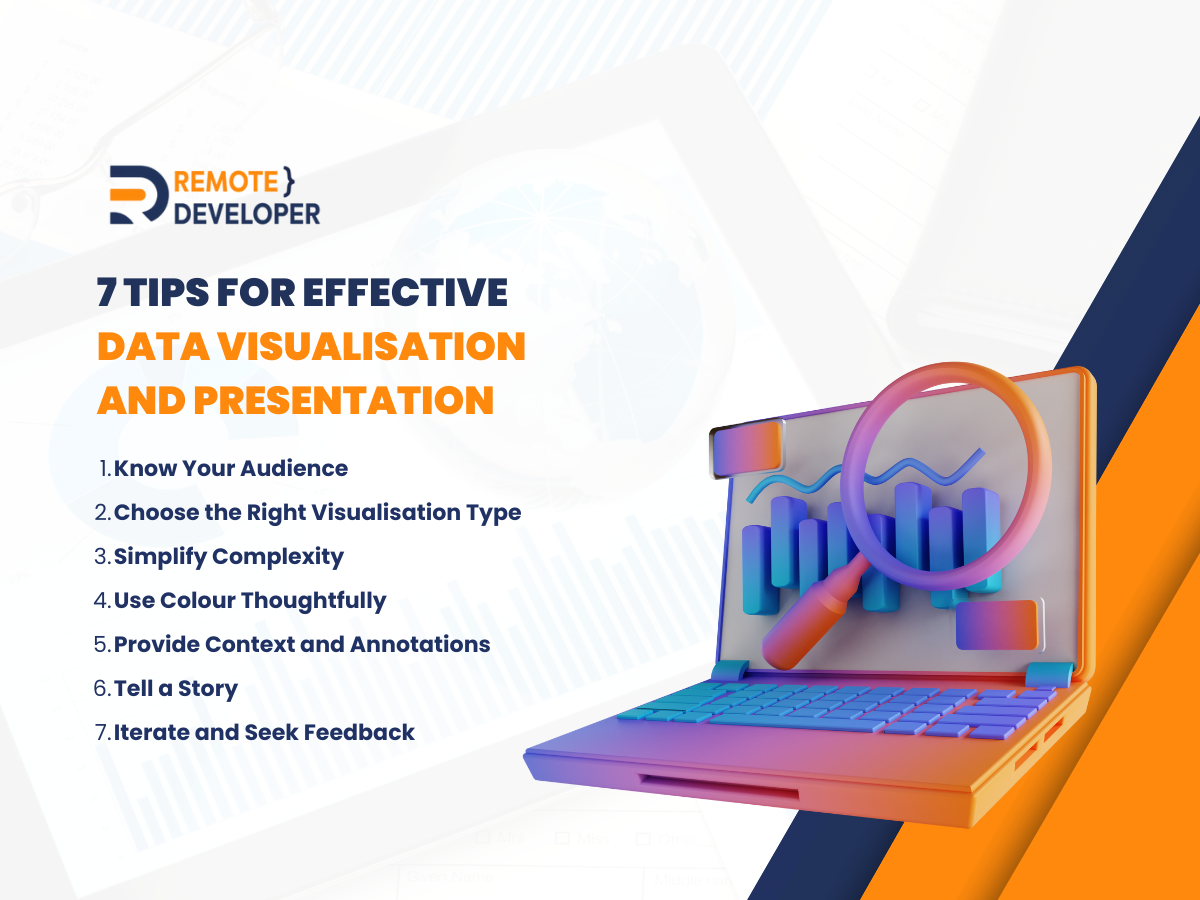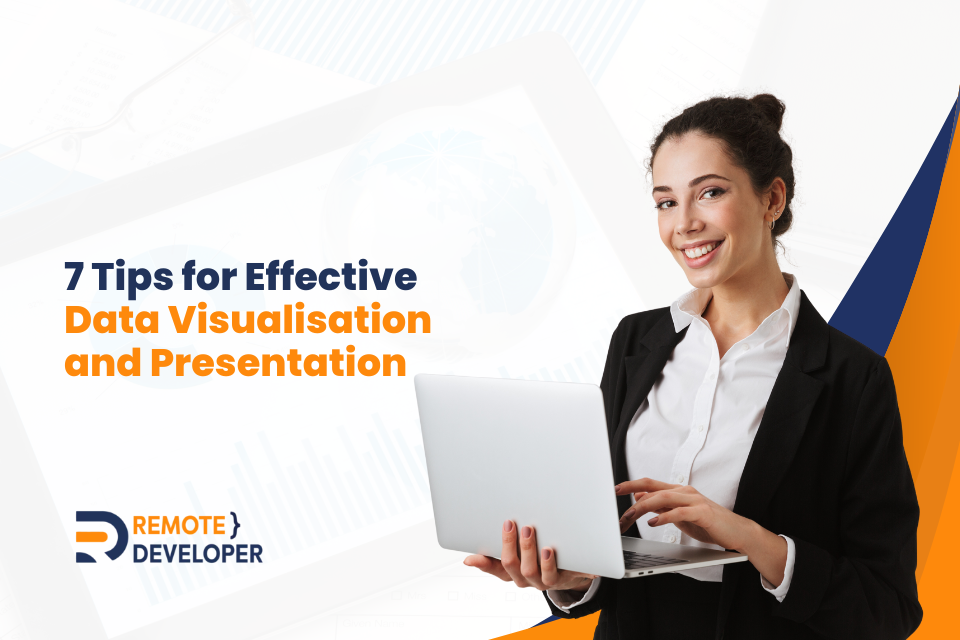In the age of information, data has become the lifeblood of decision-making in various fields, ranging from business and science to education and public policy. However, raw data alone can be overwhelming and challenging to interpret. To truly con
vey the significance of your findings or to make informed decisions, you need to present your data in a way that resonates with your audience.
This is where data visualisation comes into play. Data visualisation is the art of representing complex data sets through graphical and visual means, making it easier to understand patterns, trends, and insights.
In this article, we will delve into the realm of data visualisation and presentation, uncovering seven invaluable tips that will propel your ability to communicate complex information with precision and impact. From understanding the nuances of your audience to wielding the right visual tools and crafting narratives that captivate, these tips will equip you to navigate the intricate terrain of data with finesse.
What is data visualisation?
Data visualisation is the graphical representation of data and information using visual elements such as charts, graphs, maps, and diagrams. It is a way to communicate complex datasets clearly and concisely, making it easier to understand patterns, relationships, trends, and insights hidden within the raw data.
In essence, data visualisation transforms numbers, statistics, and other data points into visual representations that can be quickly interpreted and analysed.
Importance of data visualisation in conveying information
Data visualisation aims to facilitate understanding and decision-making by presenting information visually. Humans are naturally inclined to process visual information more effectively than raw numbers or textual descriptions.
Thus, data visualisation helps to simplify complex information, highlight key points, and make data more accessible to a broader audience, regardless of their level of expertise in the subject matter.
Here are some other reasons why data visualisation is essential:
- Enhancing Clarity. Raw data can often be perplexing and challenging to decipher. Data visualisation translates these abstract figures into visual representations such as graphs, charts, and diagrams. This clarity minimises ambiguity and ensures that the audience grasps the core message.
- Unveiling Insights. When information is presented visually, relationships, correlations, and outliers become evident. Whether identifying consumer behaviour patterns or discovering anomalies in a scientific study, data visualisation acts as a lens through which hidden insights are brought to light.
- Increasing Engagement. Visuals have a compelling impact on human cognition. They captivate attention and engage the viewer’s mind more effectively than textual information alone. This heightened engagement ensures that the information presented is understood and retained for a longer duration.
- Enabling Effective Storytelling. Humans are wired to connect with stories. Data visualisation transforms data into narratives, guiding the audience through a sequence of compelling visualisations. This storytelling approach not only educates but also resonates emotionally, allowing the audience to relate to and internalise the information being presented.
- Prompting Informed Decision-Making. Data visualisation provides immediate insights, allowing decision-makers to spot real-time trends, anomalies, and shifts. Whether a business executive analysing market trends or a healthcare professional monitoring patient data, data visualisation aids swift and informed choices.
7 Tips for Effective Data Visualisation
Whether you are a researcher presenting findings or a teacher conveying information to students, mastering the art of effective data visualisation and presentation is crucial. Here are seven essential tips to guide you!

1. Know Your Audience
The first step in this data visualisation guidelines is to understand your target audience. Different audiences have varying levels of familiarity with data and other preferences for visual representation. Are you addressing experts in the field, or is your audience more general?
Tailor your visualisations to match the expectations and knowledge of your viewers. This will ensure that your message is clear and resonates with your audience.
2. Choose the Right Visualisation Type
The next tip for effective data visualisation is choosing the right way to present it. Many visualisation types are available, from bar charts and line graphs to scatter plots and heatmaps. The choice of visualisation type should be based on the nature of the data and the insights you aim to convey.
For instance, use bar charts to compare quantities, line graphs to show trends over time, and pie charts to depict parts of a whole. Choosing the right type enhances the clarity of your message and minimises confusion.
3. Simplify Complexity
Another critical data visualisation best practice is simplifying things. While data may be intricate, your visualisations should be straightforward. Avoid cluttering your visuals with excessive data points, labels, or decorations.
Strive for clarity and focus on highlighting the critical information. Remove unnecessary elements that could distract your audience from the main message. Remember, less is often more in effective data visualisation.
4. Use Colour Thoughtfully
Another critical tip for effective data visualisation is using colour. Colour can significantly enhance your graphs’ visual appeal and comprehension, but it should be used thoughtfully.
Likewise, try to choose a colour palette that aligns with the emotions and associations you want to convey. Ensure that colours are easily distinguishable for individuals with colour vision deficiencies. Also, avoid overwhelming your visuals with too many colours, which can confuse and mislead your audience.
5. Provide Context and Annotations
Effective data visualisation should also have the proper context and annotations. Data visualisations don’t exist in isolation; they are part of a broader narrative. Contextual information offers a backdrop against which the data can be understood. Without context, data points might appear random or ambiguous.
Thus, provide context by adding titles, captions, and axis labels that explain what the visualisation represents. Moreover, use annotations to highlight specific data points or events of interest. Annotations guide your audience’s attention and add depth to your visualisation’s story.
6. Tell a Story
Effective data visualisation is more than just presenting numbers – it’s about telling a story. Storytelling engages your audience emotionally and intellectually, making your presentation memorable and impactful.
Likewise, arrange your visualisations in a logical sequence for effective data visualisation that guides your audience through the information. Start with a compelling title or question, present the data, and conclude with insights drawn from the data.
7. Iterate and Seek Feedback
The last tip is iteration. Creating compelling and effective data visualisations is an iterative process; continuous refinement is vital.
Likewise, don’t hesitate to experiment with different visualisation styles and layouts. Share your drafts with colleagues or friends and gather feedback. Feedback can provide fresh perspectives and help you identify areas needing improvement.
Conclusion
In conclusion, data visualisation is essential for transforming complex data into meaningful insights. You can create impactful visualisations that effectively communicate your message by considering tips for effective data visualisation.
However, this is just the beginning of your journey. If you’re hungry for more insights and techniques to enhance your capability, dive into our remote developer’s blog page! You’ll discover various valuable tips, tricks, and strategies from experts in the field.

